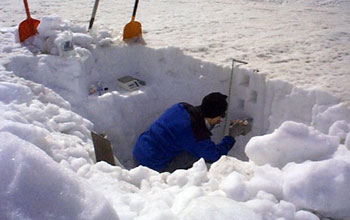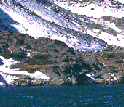|

Press Release 05-090
Unseen Colorado Mountain Aquifers Throw Water on "Teflon Basin" Myth

May 27, 2005
New research shows that high-altitude aquifers honeycomb parts of the Colorado Rockies, trapping snow melt and debunking the myth that high mountain valleys act as "Teflon basins" to rush water downstream.
Scientist Mark Williams of the University of Colorado at Boulder conducted geochemical studies that show that less than half of the annual snow melt in the Green Lakes Valley in the mountains west of Boulder arrives at a downstream watershed treatment facility as "new water." He found that most of the water sampled from North Boulder Creek during runoff months was "old groundwater" that had been stored in subterranean mountain catchments.
"We're seeing that snow melt is re-charging the hydrologic systems in the mountains, pushing old groundwater from subsurface reservoirs into rivers and streams," Williams said. "The common perception that water stored in mountain snow packs runs immediately into streams and rivers is probably wrong, and the Teflon basin myth is incorrect."
Groundwater in the Green Lakes Valley on Niwot Ridge -- a National Science Foundation (NSF)-funded Long Term Ecological Research (LTER) site -- appears to be stored in a huge catacomb of rock that Williams likened to a tiered cake. Researchers sampled surface snow and rain as well as streams, lakes and springs in the area, at tree line and above.
Similar studies by Williams and colleagues near Leadville, Colo., showed that high-mountain groundwater is dominated by snow melt that is locked underground for years or decades. Water from the snow pack replenishes high-altitude groundwater reservoirs, pooling underground rather than rushing downstream toward the plains.
"A greater understanding of how human activities impact the water in our aquifers, streams and rivers is critical," says Henry Gholz, director of NSF's LTER program. "This research demonstrates how wrong our simplifications can be."
The many fault and fracture zones in the Rocky Mountains are the primary portals to the hidden catchments, he said. But the complex geology overlying the mountain aquifers continues to challenge researchers.
"The significant delay between the time we saw water entering the system at the top end and the time it showed up in the creeks was surprising," Williams said.
The researchers found that just before the peak spring runoff, more than 50 percent of the flow in North Boulder Creek above tree line was old groundwater. During the weeks immediately following the peak runoff flow, the amount of aging groundwater in the creek jumped to roughly 80 percent, he said.
"But we don't yet know how connected high-mountain groundwater is to the large, well-known aquifers on the eastern plains," Williams said. "We need to investigate this possible connection."
-NSF-

Media Contacts
Cheryl L. Dybas, NSF (703) 292-7734 cdybas@nsf.gov

The National Science Foundation (NSF) is an independent federal agency that supports fundamental research and education across all fields of science and engineering. In fiscal year (FY) 2009, its budget is $9.5 billion, which includes $3.0 billion provided through the American Recovery and Reinvestment Act. NSF funds reach all 50 states through grants to over 1,900 universities and institutions. Each year, NSF receives about 44,400 competitive requests for funding, and makes over 11,500 new funding awards. NSF also awards over $400 million in professional and service contracts yearly.
 Get News Updates by Email Get News Updates by Email
Useful NSF Web Sites:
NSF Home Page: http://www.nsf.gov
NSF News: http://www.nsf.gov/news/
For the News Media: http://www.nsf.gov/news/newsroom.jsp
Science and Engineering Statistics: http://www.nsf.gov/statistics/
Awards Searches: http://www.nsf.gov/awardsearch/
| 


